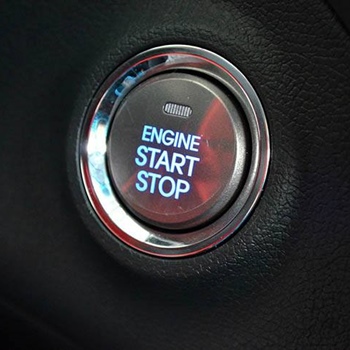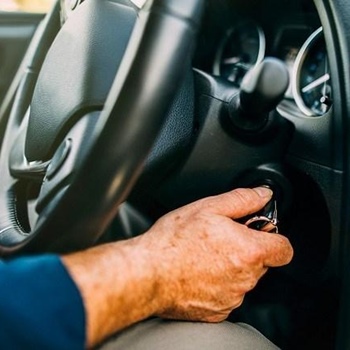Vehicles are intricate things. But every once in a while, the car just won’t start. Now, due to its complexity, the source of this issue is not that easy to pin down. However, if you read my blogs, you probably noticed that there is a list of common issues that account for most of these vehicle problems.
One such issue is the car starter. You know that sound you hear as soon as you turn the key. Well, that is the starter motor helping the engine (the big internal-combustion one) with, well, starting. In the sections below, I will try to give you the layman’s version of everything car starter related. Truth be told, this car part is one of the simpler, but If it fails, the whole vehicle is useless. Let get down to the brass tacks.
What Is A Car Starter?
 A car starter, also known as a starter motor, is an independent piece of tech under the hood with a single goal – starting the car. Now, despite the fact that this is a fairly simple car part (compared to, let’s say, the engine) if it fails the car won’t start. The starter works together with the car battery to create enough momentum for the engine, while the spark plugs ignite the air-gas mix. But let’s leave the internal combustion concept for another day.
A car starter, also known as a starter motor, is an independent piece of tech under the hood with a single goal – starting the car. Now, despite the fact that this is a fairly simple car part (compared to, let’s say, the engine) if it fails the car won’t start. The starter works together with the car battery to create enough momentum for the engine, while the spark plugs ignite the air-gas mix. But let’s leave the internal combustion concept for another day.
The reason for going through the starting system of a car is simple – in most cases when starting fails, it is not the starter itself, but a part of the whole starting system.
The Starting System
This whole car’s vital organ is consisted of several parts, with each and every part in charge of one, or sometimes even multiple roles:
- The car battery – It all starts here. The car battery has 2 integral parts to play in both car starting and ignition.
- The battery turns the starter motor on
- It also provides the necessary “jolt” of energy to the spark plugs which is needed for the ignition
- The starter motor – also known as the crank. Remember those old movie cars that needed to be started by hand, by literally turning the crank? Well, that is what a modern starter does, but it uses the battery’s electricity instead of elbow grease.
- The alternator – this part we talked about in our battery-alternator blog. I would just like to stress out that the alternator is an integral part of the starting system because it’s in charge of keeping the battery in a good state.
So, essentially this is what happens:
- You turn the key and the battery sends the direct current to the starter
- The starter motor begins turning and moving the engine
- The engine needs this initial “push” so it can start the 4-stroke cycle. In this case, it starts sucking in the fuel
- Once this is set in motion, the engine starts its internal combustion, moving the rest of the vehicle and the alternator
- The alternator charges the battery and the cycle finishes.
Signs of a Car Starter Going Bad
 Reasons for starter failure range from light to heavy with each issue showing similar signs. While I cannot educate you on each and every starter issue, I can offer you a list of the most common signs of starter motor misbehavior.
Reasons for starter failure range from light to heavy with each issue showing similar signs. While I cannot educate you on each and every starter issue, I can offer you a list of the most common signs of starter motor misbehavior.
Keep in mind that these issues may tell give you vital info on some other malfunctioning part. If you are not sure how to proceed, it is always a safe option to go to a professional. The most common signs of a car starter going bad are:
- No feedback on start – there is no motor engagement at all and everything stands still when you turn the key. This may also be a result of a faulty battery but check the starter 1st.
- The starter takes time to crank the engine – also could be a battery issue, if the starter isn’t getting enough power to turn the engine enough for it to start the cycle.
- The cranking is too loud – Sometimes, wear and tear are the culprits at fault. The bearings and other movable parts of the starter motor may have simply worn out.
- Grinding sound and vibrations – if this is the case, there is a possibility that the starter didn’t turn off when it was supposed to. A starter running all the time is as big of a problem as the one not engaging at all.
- No engine turn-over – If you turn the key and hear only one strong click, the starter is getting power, but doesn’t have the power to turn the engine over.
Causes of Car Starter Failure
Every car part has its life expectancy, and car starters are no exception to the rule. The biggest factor in this equation is none other than – time. As you already know, a starter motor is just that – a motor. And each and every motor has moving parts and bearings. When it comes to starter motors, these are the first to go when time bites down.
Another reason for car starter failure is a faulty battery. Over a longer period of time, a battery that doesn’t provide a steady flow of DC for the starter to use, the starter may start misbehaving. This gets us to the next point: faulty cables and connections.
The contact points inside the starter motor can get burned or disconnected. The solenoid the wires get connected to gets hot. Keeping a heavy-duty machine with a lot of moving parts is a hard task, that is why starter motors have their own shells and special place under the hood.
Brushes
When it comes to physical damage to the starter, we must mention the brushes as well. The starter is an electrical motor that uses DC to operate. A lot of motors like these have brushed surfaces inside (skipping the technical details on purpose). However, these metal brushes get worn out over time as well, so the starter’s performance starts dropping too.
Lastly, it is important to mention the physical damage that starter engines endure. If you drive off-road often or live in an area with bad asphalt laying all around, bumpy rides can contribute to starter motor damages and, of course, failure to start. SUVs, and bigger vehicles in general, have anti-shock gear under the hood, but if you go on off-road adventures inside an older car model, make sure to check the state under the hood more often. You’d be surprised by how many problems are solved by just reconnecting a cable or a pipe that latched off due to bumpy roads.
How to Prevent Car Starter Failure?
I am a strong proponent of regular car maintenance – and because of that, I say – the best way to prevent car issues is to actually be involved with the maintenance process. But, since car health is a tedious task to keep doing at all times, some mistakes and failures slip though.
The best way to approach car starter failure prevention is to keep the rest of the starting system healthy and under check. Here are a few examples:
- Keep your car battery in a healthy condition. This means not letting it empty out often, or even better – don’t let it empty out ever. Another way to make sure you will always have some juice to start the starter is to have a pair of trustworthy jumper cables inside the trunk of your car.
- Check the alternator every once and again – Since the alternator plays a key role in maintaining the battery, you should check on it as well.
- Take your car to a full inspection regularly – regardless of whether your state has mandatory car inspections, you should do a check-up like this at least once a year. Being road-safe is paramount, and car inspection will show you what to fix.
Replacing a Car Starter – How Often?
 So, let’s say that your starter failed for a few times now, and you decided it is finally time to invest in a new one, or at least repair this one. Your car starter should have lasted you for at least 100,000 miles, but some vehicles have their starters last for a lifetime. The thing is, the durability of your car’s starter motor (like many other parts) heavily depends on the conditions you drive in:
So, let’s say that your starter failed for a few times now, and you decided it is finally time to invest in a new one, or at least repair this one. Your car starter should have lasted you for at least 100,000 miles, but some vehicles have their starters last for a lifetime. The thing is, the durability of your car’s starter motor (like many other parts) heavily depends on the conditions you drive in:
- The road quality.
- The elements – heavy-duty parts don’t do well in freezing temperatures, batteries included
- How often do you empty the battery, if at all?
- Towing – if you tow other vehicles or trailers often, your car’s interior gets under more strain, thus speeding up the wear and tear.
- The way you drive – stop and go driving is known to hurt the car interior over long periods of time.
Some people measure the starter durability in, well, the number of successful starts. On a standard urban vehicle, you should get around 80,000 starts. But all these stats should be taken with a grain of salt since environmental factors play such a huge role.
Wrap Up
The purpose of these small guides and tutorials is to help you realize that there is no place for panic in the world of automobiles. Truth be told, solving a car problem on your own is a feeling you kind of get hooked on. Besides saving money, you will save the most valuable resource there is – time. You’d be amazed by how many breakdowns on the road are falsa alarms, and issues that are resolved in the blink of an eye.
Lastly, I shared my knowledge on the topic because preventing car issues is often hidden in maintenance. Take a few hours a month to check on how your car is really doing under the hood, and I promise you it will thank you with purring and steady performance. Have fun and stay safe on the road!